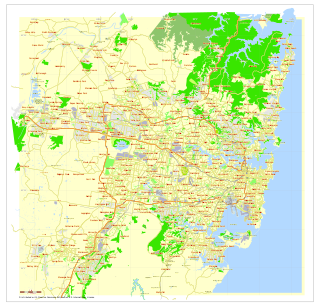Jedda is a 1955 Australian film written, produced and directed by Charles Chauvel. His last film, it is notable for being the first to star two Aboriginal actors, Robert Tudawali, and Ngarla Kunoth, now known as Rosalie Kunoth-Monks, in the leading roles. It was also the first Australian feature film to be shot in colour.

Stuart Highway is one of Australia's major highways. It runs from Darwin, Northern Territory, in the north, via Tennant Creek and Alice Springs, to Port Augusta, South Australia, in the south – a distance of 2,834 km (1,761 mi). Its northern and southern extremities are segments of Australia's Highway 1. The principal north-south route through the central interior of mainland Australia, the highway is often referred to simply as "The Track".

Malanda is a town and locality on the Atherton Tableland in the Tablelands Region, Far North Queensland, Australia. In the 2011 census, Malanda had a population of 2,052 people. Malanda first developed in the 1900s after the discovery of tin and copper at Herberton saw a steady stream of miners and engineers moving over the mountains from the coast.
We of the Never Never is an autobiographical novel by Jeannie Gunn first published in 1908. Although published as a novel, it is an account of the author's experiences in 1902 at Elsey Station near Mataranka, Northern Territory in which she changed the names of people to obscure their identities. She published this book under the name Mrs Aeneas Gunn, using her husband's first and last name. Over the years newspapers and magazine articles chronicled the fortunes of the Elsey characters: Jeannie outlived all but Bett-Bett.

Southport is an outer rural locality in Darwin. It is based on the site of the abandoned Town of Southport, a thriving river port during the Pine Creek gold rush of the 1870s. It is located at the junction of the Blackmore and Darwin Rivers.

The Victoria Hotel, or The Vic as it is commonly known, is a heritage listed pub located in Darwin, Northern Territory, Australia. Built in 1890, it is an important historical building but is currently closed.

Jessie Sinclair Litchfield was an Australian author and Northern Territory pioneer.

Ormond Harold Edward George Snell, best known as Harold Snell, was a soldier, miner, primary producer, carpenter, builder and businessman in the Northern Territory of Australia. He built many historic buildings in Darwin.

Ellen Mary Stack is an Australian medical doctor and the first female Lord Mayor of an Australian capital city. She was the first Lord Mayor of Darwin, Northern Territory from 1975 to 1980. She is best known for her work following the destruction of Darwin due to Cyclone Tracy.

Hotel Darwin was a hotel located on the Esplanade in central Darwin in the Northern Territory of Australia. It was commonly known as the "Grand Old Duchess". Despite surviving the Bombing of Darwin and Cyclone Tracy, the hotel was demolished in 1999. A bar at the rear of the original site formerly known as the Hot & Cold Bar now functions under the name Hotel Darwin.
Ellen Ryan was a publican and entrepreneur who became one of the richest women in the Northern Territory of Australia.

Lee Toy Kim better known as Granny Lum Loy or Lu Moo was a renowned Chinese businesswoman in Darwin in the Northern Territory of Australia.

Lillian Maud Dean was a photographer and local government politician in Darwin in the Northern Territory of Australia. She was the first woman to be elected to local council in the Northern Territory.

Sue Wah Chin was a Chinese entrepreneur living and working in Darwin in the Northern Territory of Australia. The Sue Wah Chin or 'Stonehouse' building, one of the remaining heritage buildings in central Darwin, is named after her.
Elsie "Ma" May Jenkins was an opal and mica miner who worked at Lightning Ridge and Coober Pedy in South Australia and Alice Springs in the Northern Territory of Australia. She is best known as the “Opal Queen” referencing her impressive opal collection.
Michelle Sue "Mickey" Dewar was an Australian historian who specialised in the history of the Northern Territory.
Norma Catherine (Billie), Pitcheneder, nee Harris also Nichols was a prolific fundraiser and community worker of Darwin in the Northern Territory of Australia. She was best known as "Auntie Billie".
Shirley Naomi Brown is an Australian author who has written extensively about the history of Alice Springs in the Northern Territory of Australia.
Mary Costello was a pioneering pastoralist in the Northern Territory of Australia.




















